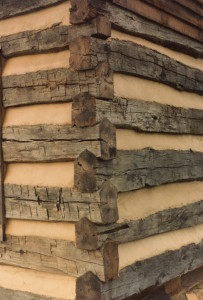A corner of this log cabin… before… and after, it is chinked. I like both images… but, it always fascinates me how a stack of individual logs is visually transformed into a solid wall, all because of the application of a little cement.
Originally posted 2015-05-02 14:18:20.



Noah,
My wife and I recently exposed an interior wall in our home that has log cabin construction. The chinking is still in place, but is deteriorating. The outside of the log is covered by 2 types of siding. We would like to restore the inside, but our unsure about removing the old chinking material and/or what products we should use to re-chink the logs. This portion of the home is the most original part dating back to 1834. Any assistance that you can offer would be greatly appreciated.
Hi Jason,
Congratulations on living within a historic log cabin!
I’ve created several free YouTube videos where I discuss and demonstrate chinking… here’s one of them… https://www.youtube.com/watch?v=E-bztKjHNgI
I spend a lot of time going step-by-step how to properly chink a cabin in the online Log Cabin Academy… you ought to consider joining us there… https://noahbradley.leadpages.co/logcabinacademy/
Noah
Hi Noah, Thank You for your posts. They have been so helpful. We are getting ready to chink an old homesteading log cabin built about 30 years ago. There is not a wide gap between the logs and it still has moss stuffed between, Over the top the moss are strips of cedar aprox two inches in width and about a foot long nailed along the length of the logs My questions are two. Is it best for us to remove the moss and cedar and just chink between the logs or leave it and chink over it? Im tending toward leaving it because I believe the original builder left the project just before the mortar was going to be put on and the moss and cedar were the perpetration stages used to hold the mortar in place. Just a thought. And also there is a Portland product you had mentioned in your Youtube video on chinking, that we would like to use with the colored cement. I know you use Flamingo C73. Could you please tell me what the exact name of that product is? I love the look and also do not like the gray concrete look. Our cabin is in North West BC, Canada. Very secluded. Thank You so much. I look forward to your reply.
Maria,
I would think that the original builder of the cabin installed the cedar strips as a way of holding the moss in place and as an attempt to keep the cold (and various species of vermin) from entering the cabin. This cedar will not make a good medium to properly hold your chinking into place and so I would recommend removing it and installing diamond mesh lathing. BTW… moss for insulation is much better than nothing… but there are products such as fiberglass insulation or foam that is MUCH better at keeping a cabin comfortable.
The brand and item number on the cement I use is Flamingo C73… if it is not available in your area likely there is a type of dyed cement that is available and the supplier can reference the Flamingo color chart to find you a suitable match that will likely be of an equal quality and appearance.
Noah
Noah
We have a round big logs different sizes on our log home. It has chinking on it . It needs to be rechinked but I want to do it with cement what and how do I start. Its a big home and we don’t have much money to redo it but it has to be done.
Round Logs are more challenging to chink than hewn ones… I have chinked several round log cabins (it was a popular and quick method of construction during the Great Depression). I chink them the same way as I do hewn log cabins with an added emphasis and procedure of meticulously caulking the top of each chink joint where it comes in contact with the log above. This caulking should be carefully inspected yearly to ensure that no water can enter the chink joint and create rot.
Hi Noah, we’re redoing the inside of a log house but leaving the siding on the outside. Can we use a thin layer of spray foam on the outside edge of the logs for an air barrier, and fiberglass on the inside of that layer? We’re planning to use cement chinking for the final inside layer. I’m concerned about condensation between the foam and cement.
Aaron, it’s hard for me to answer your question as there are so many variables, and I’m not quite clear on some of the details.
In your situation the proper place to stop moisture and air infiltration is directly behind the siding with the use of a vapor barrier product.
I do often use foam in my chinking as it really does a great job at stopping air infiltration… but in your situation… again, knowing what I know, and not knowing a few things, I would be tempted to bypass the use of foam and stick with fiberglass insulation.